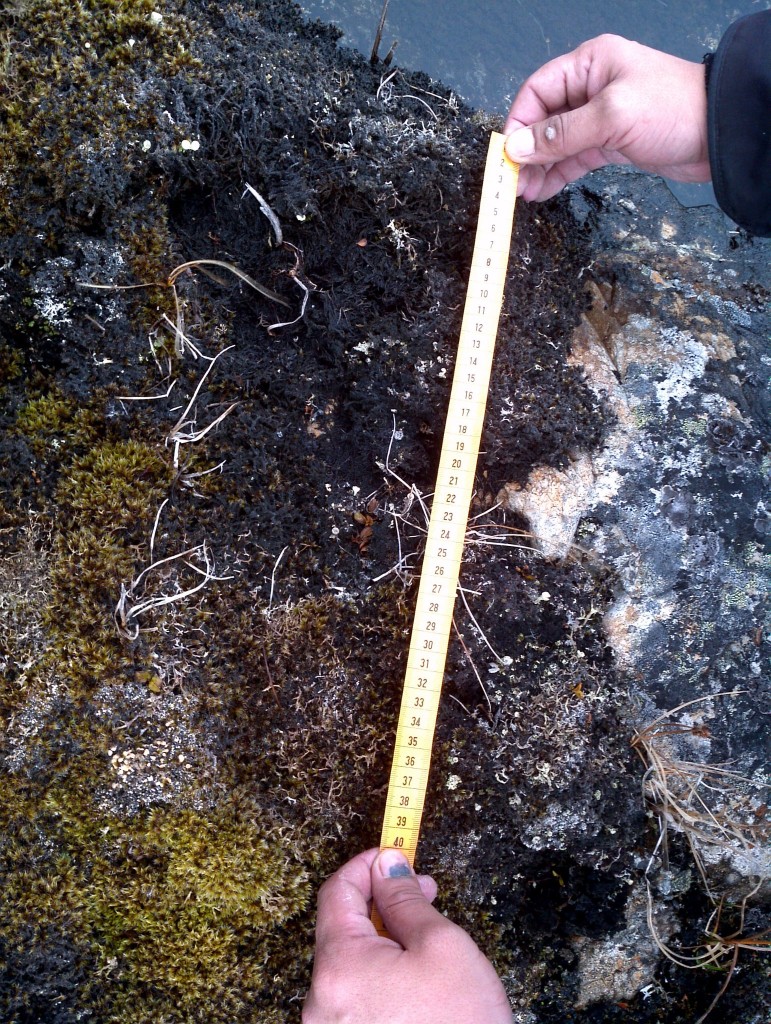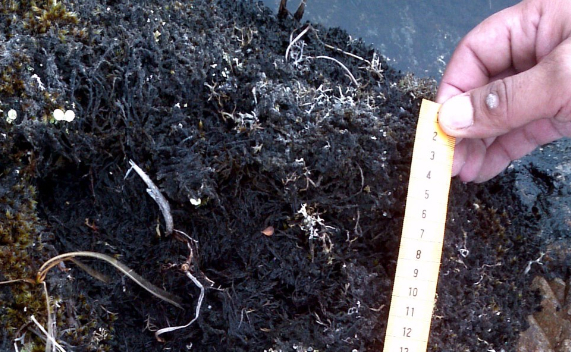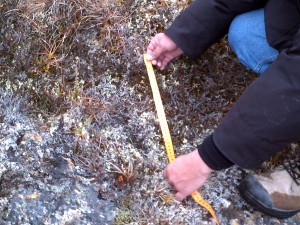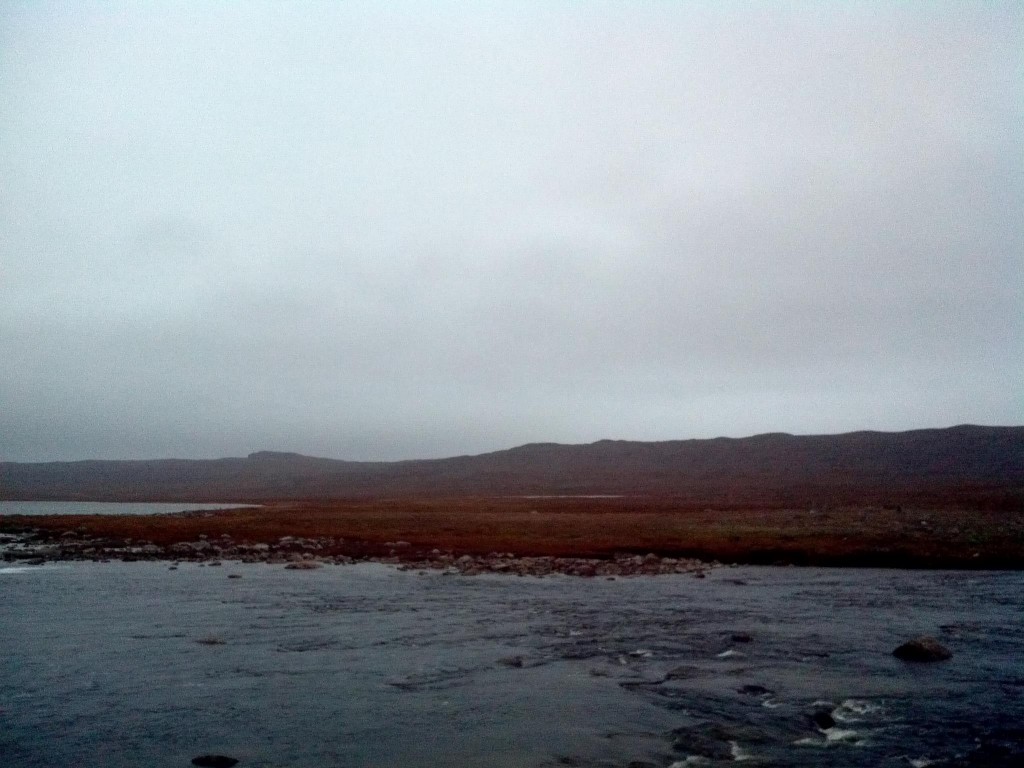
October 4, 2012
Jane Sponagle’s article has been published by the CBC. See earlier story here.
Here’s the latest. This is a breaking story. This sighting and these tracks were left less than a week ago.
First the published footprint photos.

The news article says the footprint measures 40 centimetres in length. This is a clarification from yesterday, when I was told 44 cm. Forty cm is equal to 15.748 inches, while 44 is over 17 inches. This is definitely within Sasquatch parameters.
Looking at the photograph carefully, it appears there are four toes here (a trait of the True Giants) versus five. But in the tundra mud, it is difficult to tell.


The second photo of another track does not show as much detail, but you get a good look at the terrain.
Specific details are contained in the new news item. The two women, one named Maggie Cruikshank Qingalik, who is from Akulivik, Quebec, were picking berries on Saturday, September 29, 2012. They saw the creature “out in the wilderness,” and said it was “covered in long, dark hair.”

(BTW, Akulivik is an Inuit village in Nunavik, in northern Quebec, Canada. It is located on a peninsula that juts southwesterly into Hudson Bay across from Smith Island. Akulivik is on the 60th parallel north, 1,850 km north of Montreal.)
As Qingalik says, they were on “the other side of the river, akianii” in the area shown in this photo:

In September.

In August.
Sponagle said that Qingalik remarked “it was walking upright along the side of a hill, and was taking long strides. They said it would also sometimes crawl.”
“We weren’t sure what it was first. It is not a human being, it was really tall, and kept coming towards our direction and we could tell it was not a human,” Qingalik said.
They thought it was another person picking berries, but then noticed it was hairy. The reporter told me they said that they were certain it wasn’t a bear or a musk oxen, the two animals they immediately thought as a being big and hairy.
Qingalik said the creature was 10 feet tall.
The article encompasses part of the reporter’s notes on her interview with me:
Expert says sightings not rare in Canada
Loren Coleman, the director of the International Cryptozoology Museum in Portland, Maine, has been studying Sasquatch and Bigfoot sightings in North America for more than 50 years.“It sounds like a traditional kind of sighting. I think the only thing I would wonder about would be the height of 10 feet with a footprint as large as you said. But that happens people exaggerate,” he said.
Coleman said Bigfoot or Sasquatch tend to be six and a half to eight feet tall. He said they have been spotted throughout the U.S. and Canada since the 1800s.
Since the region has become more populated, Coleman said the sightings have been relegated to the wilderness.
He said he hopes someone took measurements and some good photographs of this most recent sighting.
“If someone could go back there and take some plaster casts, that might be quite helpful in terms of comparing it to the database of other footprints in Canada,” he said.
In Nunavik or Nunavut, Coleman suggests Sasquatch may hole up in caves to protect themselves from the elements.
He added they may sustain themselves on a diet similar to caribou. However, he said the omnivores are opportunistic and could eat a range of food including salmon or road kill.
Coleman said he is skeptical when he investigates these sightings. He said he wants to make sure it is not just a common animal, or people trying to make a buck. Source
I talked to Sponagle in the broader context about skeptical & open-minded investigations. As she correctly reported, I made no statements about these two eyewitnesses, because I have not interviewed this folks who saw this and know their own region. I did make the suggestion, in this specific case, if the tracks could be relocated, that casts should be made, as it would further the examination of this evidence. I congratulate Maggie Cruikshank and her friend for stepping forward and sharing this new important information.

As I mentioned yesterday in my posting here, besides this sighting near Akulivik, an Inuit village in Nunavik, in northern Quebec, there have also been recent sightings farther north, near Iqaluit, Nunavut, Canada. I appreciate Jane Sponagle contacting me, as this quickly gets these new sighting reports and footprint photographs into the database, for further study.

About Loren Coleman
Loren Coleman is one of the world’s leading cryptozoologists, some say “the” leading living cryptozoologist. Certainly, he is acknowledged as the current living American researcher and writer who has most popularized cryptozoology in the late 20th and early 21st centuries.
Starting his fieldwork and investigations in 1960, after traveling and trekking extensively in pursuit of cryptozoological mysteries, Coleman began writing to share his experiences in 1969. An honorary member of Ivan T. Sanderson’s Society for the Investigation of the Unexplained in the 1970s, Coleman has been bestowed with similar honorary memberships of the North Idaho College Cryptozoology Club in 1983, and in subsequent years, that of the British Columbia Scientific Cryptozoology Club, CryptoSafari International, and other international organizations. He was also a Life Member and Benefactor of the International Society of Cryptozoology (now-defunct).
Loren Coleman’s daily blog, as a member of the Cryptomundo Team, served as an ongoing avenue of communication for the ever-growing body of cryptozoo news from 2005 through 2013. He returned as an infrequent contributor beginning Halloween week of 2015.
Coleman is the founder in 2003, and current director of the International Cryptozoology Museum in Portland, Maine.
Filed under Bigfoot, Breaking News, Cryptomundo Exclusive, CryptoZoo News, Evidence, Footprint Evidence, Sasquatch, True Giant, Windigo